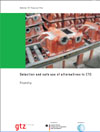| |
FOUNDRY SECTOR |
The two major applications of CTC usage in foundry sector are: |
| PARTICULATE ANALYSIS (MILLIPORE TEST) |
In precision component manufacturing and foundries cleanliness specifications are often determined by the original equipment manufacturer (OEM). Residual particle analysis, commonly referred to as the Millipore test, is typically specified to verify the cleanliness achieved.
Contaminants are removed from the sample part by rinsing, brushing and/or flushing with a solvent (e.g. CTC). This solution is then vacuum filtered through a membrane filter which collects the contaminants that are greater in size than the grid size of the filter. The quantum of the contaminants thus collected is then compared to the acceptance criteria.
|
|
SAMPLING OF RAW MATERIAL |
In foundries the quantum of wastage in the scrap used as raw material is assessed by using the following method. The sample material is rinsed with solvents like CTC and then dried through heating. The difference in weight of the sample before and after rinsing determines the quantum of wastage. Since the material is dried directly on a source of heat it is important to select a solvent that is non flammable.
Sl. No |
Particulate analysis |
Sampling of raw material: |
1 |
Toluene |
Methylene Dichloride (MDC) |
2 |
White petrol |
Perchloroethylene (PCE) |
3 |
Perchloro ethylene (PCE) |
|
4 |
Isopropyl Alcohol (IPA) |
|
Trichloroethylene (TCE) is another cleaning agent used by some industries. Its use is strongly discouraged because of the inherent cancer risk
HAZARDS TO CONSIDER
|
 |
|
Every substance has limitations. While every solvent is toxic to a certain extent, the harmfulness varies from one substance to another. A given substance may be hazardous on skin contact, be a fire hazard, harm the environment and / or cause cancer (i.e. red category. ). Knowledge on the hazard ratings will help industries to take appropriate preventive measures and detailed information on hazards and control measures are provided in the TA. |
FURTHER INFORMATION
A detailed technical document titled "Selection and Safe Use of Alternatives to CTC – Foundry" is available for free download. .

Download the document here
Comments? Questions? Suggestions? Please click
here
to let us know!
|
Disclaimer
Ü Though all care
has been taken while researching and compiling the information presented
above, GTZ Proklima accepts no liability for its accuracy. The reader is
advised to confirm its correctness prior to use or purchase of any substance.
Ü GTZ Proklima
makes no claim in respect of the suitability of any substance as substitute
for CTC in any specific industrial process. Suitability remains to be verified
through trials with due consideration of health and safety aspects.
Ü Information provided here
does not constitute an endorsement or recommendation of any product by GTZ
Proklima. While preference is given to non-proprietary products information on
selected proprietary products may be included if they appear to have a better
environment, health and safety performance or if they are already widely
adopted by the industry.
|
|

